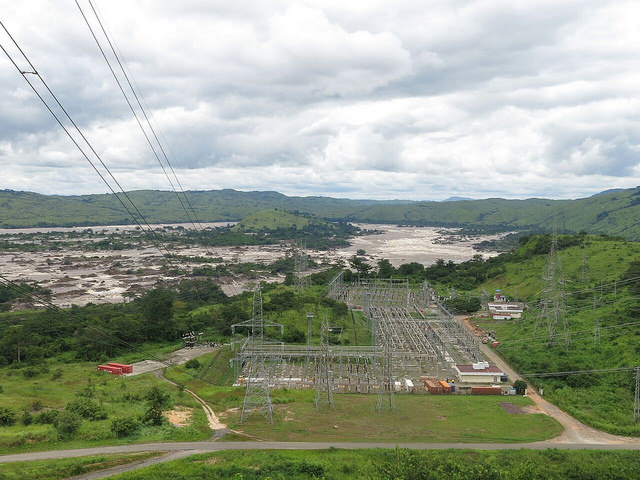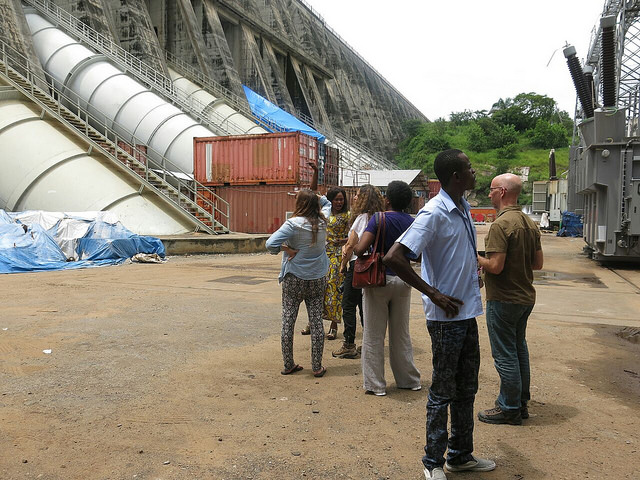http://e-info.org.tw/node/115747
賣電求生 剛果蓋世界最大水壩 無環評趕年底開工
文字大小
299 1 Share1
本報2016年6月1日綜合外電報導,姜唯編譯;蔡麗伶審校
全世界最大的水壩將坐落於剛果民主共和國,並在數月內開工,五年內開始發電。但是批評者指出,屆時將有3萬5000人必須搬家,而且沒有任何環境社會風險評估。
剛果超級大壩第一期「印加三號」位址。圖片來源:International Rivers(CC BY-NC-SA 2.0)。
剛果民主共和國正在加緊趕工超級大壩的第一期——造價140億美元的「印加三號」。「印加三號」位於印加瀑布上,將跨越剛果河的一個水道,是一座4800MW的水力發電廠。
接下來的幾期工程,耗資總共約1000億美元,將跨越全世界水量第二大的剛果河,預計發電容量達4萬MW——近中國三峽大壩的兩倍,或20個大型核電廠。
非政府組織「國際河流」(International Rivers)指出,這個延宕多時的計畫,雖然支持者聲稱可以供應非洲40%的電力,卻可能觸犯國家法律和國際守則對超級大壩開發的規範。
「國際河流」的博薩德(Peter Bosshard)表示,工程單位不在乎第一期可能必須搬遷的3萬5000人、之後的2萬5000人以及可能大幅受影響的河流漁藏。大印加計畫辦公室主任卡潘德吉(Bruno Kapandji)更表示,環境與社會評估無法在11月開工前完成。
卡潘德吉說,印加三號是剛果民主共和國能源問題的唯一解,還能輸出電力:「身為剛果人,我們別無選擇...商品價格正在下跌,我們需要收入。如果我們向加拿大和烏拉圭一樣可以輸出能源就好了。」
博薩德則批評,政府很顯然沒有在工程開始前執行社會和環境風險評估的意願,這已違反國家法律、世界銀行保護政策和中國的海外承包規範。
剛果政府加速開發計畫,以履行與南非政府簽訂的2021年前從印加三號輸出2500MW電力的合約。剛果政府將在8月前從兩個中國水壩建造商中擇一合作,並於11月開工。
卡潘德吉指出,中國建造商表示可以在四到五年內開始發電,西班牙建造商則評估要花六年時間。
剛果超級大壩第一期「印加三號」位址。。圖片來源:International Rivers(CC BY-NC-SA 2.0)。
【相關文章】
【參考資料】
Construction of world's largest dam in DR Congo could begin within months
Mega dam on Congo river to produce electricity equal to 20 large nuclear power stations, but critics say it will displace 60,000 people and wreck the ecosystem
The largest dam in the world is set to begin construction within months and could be generating electricity in under five years. But 35,000 people may have to be relocated and it could be built without any environmental or social impact surveys, say critics.
The $14bn (£9.5bn) Inga 3 project, the first part of the mega-project, is being fast-tracked by the Democratic Republic of Congo government will span one channel of the vast river Congo at Inga Falls. It involves a large dam and a 4,800MW hydro-electric plant.
But subsequent phases, together costing about $100bn, could eventually span the Congo river, the world’s second largest by volume. It is expected to have an electricity-generating capacity of nearly 40,000MW – nearly twice as much as the Three Gorges dam in China or 20 large nuclear power stations.
But the long delayed project, whose backers claim it could provide about 40% of Africa’s electricity, may violate national law and international guidelines for the development of mega-dams, according to the California-based NGO International Rivers.
Peter Bosshard, the NGO’s interim director, says those running the project are not concerned that 35,000 people may have to move in phase 1 and 25,000 people later, or that fish supplies from the river are likely to be greatly affected.
In a filmed interview with International Rivers, the head of the Grand Inga Project Office, Bruno Kapandji, suggests that environmental and social impact surveys will not be completed before work starts, possibly in November.
“It is a choice to make, people have no electricity. We set an objective – we have to produce energy,” Kapandji said. “There are a lot of studies to carry out, at least 18, and we favour some over others based on priority, and to allow us to ... develop a tender document that will be technically and financially acceptable.”
Kapandji says that Inga 3 is the “only solution” to Congo DRC’s energy problem and would allow it to export electricity: “As Congolese we have no choice but to build Inga 3. And for the cities in Kinshasa, Bas-Congo and Katanga, Inga 3 is the only solution ... Today the price of commodities is falling and we need revenue. If we have a lot of energy to export, like Canada and Uruguay, we won’t have a problem”.
Bosshard said: “Bruno Kapandji makes it clear that the government has no intention to carry out a social and environmental impact assessment for the huge project before construction starts. Developing Inga 3 without an EIA will violate national law, World Bank safeguard policies, and Chinese guidelines for overseas contractors.”
“There has been a complete disregard for affected people and the environment. It is shocking that the world’s biggest hydropower scheme could go forward without an assessment of its social and environmental impacts and a resettlement action plan in place,” said Bosshard.
The Congolese government is fast-tracking the construction to fulfil a legally binding contract signed with the South African government to supply 2,500MW of electricity from the Inga 3 by 2021. It is expected to choose a consortium of two of China’s largest dam builders by August, and hopes to start building by November.
According to Kapandji, the Chinese consortium has said electricity could be generated within four to five years. A Spanish consortium has suggested Inga 3 would take six years to build.
Big dams built in developing countries have forced many millions of people to relocate and caused immense environmental damage. But pressure from environment and development groups has forced countries and funders to commission impact surveys to assess and mitigate damage.
In 2013 and 2014, the African Development Bank and the World Bank approved $141m in grants for the preparation of the $14bn project.
An absence of environmental and social assessments could affect the financing of the project. The Chinese government has instructed its dam builders not to build any overseas projects without EIAs and both the China Three Gorges Corporation and Sinohydro, the members of the Chinese consortiums, have committed not to build any major dam projects without such assessments.
“Building the Inga 3 Dam without thorough environmental due diligence would seriously undermine the efforts of Chinese companies to strengthen their environmental track record,” said Bosshard.
At a meeting with civil society groups in April, Kapandji argued that early feasibility studies had found that the project would not have any negative impacts.
• This article was amended on 30 May 2016 because the NGO International Rivers is based in California, not Washington as an earlier version said.




沒有留言:
張貼留言